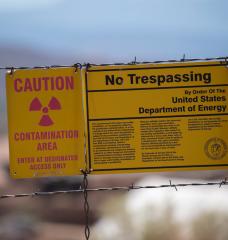Description
Listen on your favorite streaming app.
We often hear about recycling as a way to make an impact on climate change right in your own home. But how big a difference are we really making when we recycle? For this episode, Anders Damgaard, senior researcher at the Technical University of Denmark, joins the TILclimate podcast to help us understand the climate benefits of recycling—and why they depend on what we’re recycling and how.
Dr. Anders Damgaard is a senior researcher at the Department of Environmental and Resource Engineering at the Technical University of Denmark who specializes in assessing the environmental impact of waste management and resource recovery systems.
For more episodes of TILclimate by the MIT Environmental Solutions Initiative, visit tilclimate.mit.edu. Subscribe to receive notifications about new episodes and follow us on Twitter @tilclimate.
Credits
- Laur Hesse Fisher, Host and Producer
- David Lishansky, Editor and Producer
- Aaron Krol, Associate Producer
- Natalie Jones, Script Writer
- Ilana Hirschfeld, Production Assistant
- Sylvia Scharf, Education Specialist
- Michelle Harris, Fact Checker
- Music by Blue Dot Sessions
- Artwork by Aaron Krol
Transcript
[00:00:00] LHF: Hello, and welcome to Today I Learned: Climate. I’m your host Laur Hesse Fisher of the MIT Environmental Solutions Initiative.
We often hear about recycling as a way to make an impact on climate change right in our own homes. But, how big a difference are we really making when we recycle?
In today’s episode, we talked to a recycling expert to help us understand if recycling is really a climate solution.
[00:00:32] AD: My name is Anders Damgaard and I'm a senior researcher at the Technical University of Denmark where I'm sitting at an institute called Department of Environmental and Resource Engineering.
[00:00:45] LHF: Prof. Damgaard has been studying recycling and waste management for his whole career.
So let’s start with the basics. Why bother recycling at all?
[00:00:56] AD: For pretty much any material the recyclable materials are much cheaper to reprocess than the virgin materials. And this is the main reason why we do recycling. Let's take the aluminum can because it's a perfect example. When we make aluminum from raw materials, we start with bauxite ore. Then we go through a heavy purification of that and grinding up to alumina powder, which we then have to turn into aluminum, which requires insane amounts of electricity.
[00:01:28] LHF: And all that digging, grinding and refining is powered mostly by fossil fuels—which emit carbon dioxide and other climate pollution when we burn them.
But we can skip all of that if we instead start with recycled cans.
[00:01:46] AD: They are already aluminum. So we basically just have to re-melt them. And therefore, when we look at an aluminum can from recycled material, it probably has used somewhere like four to 5% of the same amount of energy it took to create it the first time from raw materials. So I mean, we saved 20 times the emissions of starting from the raw materials.
[00:02:11] LHF: Wow, let’s repeat that: we save 20x the emissions and 95% of the energy by making aluminum cans out of recycled aluminum. And those energy savings also translate into cost savings for manufacturers—so recycled aluminum can be sold at a nice profit. Which means there’s a real business here.
But the climate benefit of recycling really depends on the material.
[00:02:40] AD: There's sort of two things we go for:
things like tin cans and the aluminum can we just talked about, which is maybe making up one or 2% of our all waste amount, which is not a lot, but which has a very high environmental value carried with it from the production. And therefore, even if it's a small amount, recycling makes a lot of sense.
But then we have the other end, which is things like paper and cardboard, which maybe on a per pound basis, is not giving that big an environmental benefit, but because we recycle so much of it, we get large quantities which means there's economies of scale in doing it and there's environment of scale in doing it.
[00:03:27] LHF: Here in the U.S., we throw out over 65 million tons of paper a year and recycle about 70% of it into new paper products.
Remember, paper is made from trees, and trees store massive amounts of carbon from the atmosphere. [We have an entire episode on this called TIL about planting trees that’s actually one of my favorites.] So when we recycle so much paper and use that to make new paper products, that’s a lot of trees that aren’t being cut down.
The US Environmental Protection Agency [known as the EPA] analyzes the environmental benefits of recycling, and they found that almost all – 95% – of the climate benefits of recycling comes from recycling just these materials: paper, cardboard and metal.
This was really surprising to me, because when I think about recycling, I largely think about… plastic. But in 2018, which is the last year the EPA has data, less than 10% of plastic was recycled. Why?
[00:04:33] AD: Plastic is a complex material. There's probably more than 10,000 types of plastic on the market
[00:04:41] LHF: You know those little recycling numbers on a plastic package in that triangle with those arrows around it? They tell us what kind of basic building block—or “polymer”—a plastic is made of., Like, a plastic bag is made of a different polymer than the plastic bumper of your car. But while there are only 7 of these recycling numbers, in practice there are way more than seven kinds of plastic out there.
[00:05:08] AD: When we make a product of plastics, we put in our polymer and then we start putting in additives. And we put in additives to get different functionalities, different colors, different stiffness and hardness.
And that's often the big challenge we have actually is figuring out what is in these plastics.
[00:05:29] LHF: And some of these additives, like heavy metals in older plastic PVC pipes, are really dangerous. This all makes recycling plastic challenging. Because the workers and machines at recycling centers have to sort out all the different types of plastics—and more additives means more different types of plastic .
If they’re not perfectly sorted, they’re considered “impure” or “contaminated” and companies are generally less willing to buy them.
That’s what happened in 2018 on a global scale: Until recently, 70% of plastic recycled in the U.S., and 95% in the European Union, was sold to recyclers in China, who use the plastic to make new products. But in 2018, China started only buying plastic recyclables with almost no impurities. Since then, hundreds of cities all over America have stopped recycling some or all types of plastic, unable to sell what they were collecting.
OK but even if recyclables were perfectly sorted, the business of recycling itself also produces climate pollution.
[00:06:44] AD: There's pretty much emissions for everything, right. The collection vehicles that will pick up the recyclables, we are burning diesel, or natural gas engines. We use a lot of different machines to sort the different types of materials and they all consume electricity.
[00:07:01] LHF: And after we collect and sort them, we still have to turn our recyclables back into raw materials.
[00:07:08] AD: And of course here we use huge quantities of energy, but we also have emissions coming from the materials, impurities, et cetera, being released. This is definitely where the biggest impact from the recycling chains come.
[00:07:23] LHF: With a material like aluminum or steel, recycling saves way more emissions than it adds, as we covered in the beginning in the episode. But with something like glass, it’s not so clear cut.
[00:07:37] AD: For glass, recycling is quite a small environmental benefit. So if you are out in smaller cities where there's not glass manufacturing nearby, and we start to move a material that's very heavy and if it then costs a lot of dollars to transport it to a place where we can recycle it, we might end up saying, we would rather spend that somewhere where we get more environmental benefit for the money.
[00:08:03] LHF: Which is why many cities and countries are trying to switch the focus: instead of shelling out to recycle whatever we put in our bins, they’re trying to change the very way we design and dispose of products, so it’s easy to use all our materials again and again.
Take something called “deposit return systems.” They’re common in Europe, and in some American states: you pay 5 or 10 cents extra for a can of soda, and then get that money back when you return the can at the grocery store.
[00:08:37] AD: So there is a fiscal incentive to get these materials returned. And what we see at least in the countries in Europe that have this, we have very high recycling rates for deposit return systems. In Denmark the return rate in average, across these different types of bottles of different materials is 93%.
[00:08:58] LHF: Deposit return systems have even nudged manufacturers to make their products easier to recycle.
[00:09:06] AD: In the Danish case, the cost of operating the return system is actually coming from the producers of the goods. If you want to sell your product on the market, you have to pay into the system. And if you come with a really terrible material, you will have to pay a much higher price than if you pick a material that's easy to recycle.
[00:09:29] LHF: And a lot of new recycling policies are trying to incentivize companies to make products out of recyclable – and recycled – materials.
Take something the European Union will roll out in 2025: “extended producer responsibility.”
AD: Which is that basically the people that produce the materials that becomes waste have the fiscal responsibility to ensure that they're being recycled. So meaning producers that put a glass container on the market, they need to make sure it's being recycled. Probably what will happen is these companies will then form associations that will say, “okay, now it's collected. We will take over the material probably at a cost. And then we will make sure that it's recycled into new material.”
Or you can do what the United Kingdom does: tax new plastic. After all, we as taxpayers have to pay for unrecycled waste to go into a landfill; a tax can make manufacturers pay for some of that cost.
[00:10:42] AD: So there's a fee being put on most of the materials if it's made from virgin material where there's no fee, if it's from recycled material. So that actually means the higher recycled content you have in the material, the less you have to pay in fees.
[00:10:59] LHF: So let’s say the world made a significant effort to expand recycling: making more products recyclable and actually recycling them. Would that make a significant difference for climate change?
The short answer is, Well, yes. Project Drawdown, an organization that analyzes climate change solutions, estimates that between 2020 and 2050, if we improved recycling systems worldwide and recycled a healthy majority of the materials we consume, the world could save around 11 gigatons of carbon dioxide . That’s approximately equivalent to the 2020 CO2 emissions of the United Kingdom every year for 30 years.
So bottom line? Yes, recycling can make a dent on climate change. But for tough materials like plastic, recycling as we know it today isn’t delivering those climate benefits. To see those benefits, we’ll need bigger changes to how products are designed—and we might want to look at how much waste we’re creating in the first place.
[00:12:15] AD: What we should always start with is prevention to avoid using materials. I think it's just important when we talk recycling, especially when we also talk design, if we can design for reuse solutions, that's of course better than going straight to recycling.
We have to relearn ourselves, that any material actually has a value. And we have to appreciate that both from a fiscal point of view, but also from an environmental point of view.
[00:12:44] LHF: That’s the end of our episode—and of this season of Today I Learned: Climate. But we will be back, so stay tuned to this channel for an announcement about season 5 later this year. You can also go to tilclimate.mit.edu and look at our show notes for more information about recycling, and check out our educator guide on this episode for an engineering and design challenge for the classroom.
TILclimate is produced by the MIT Environmental Solutions Initiative at the Massachusetts Institute of Technology, where we’re tackling the plastics recycling problem. Go to environmentalsolutions.mit.edu/plastics to learn more.
David Lishansky is TILclimate’s Editor and Producer. Aaron Krol is our Associate Producer — and did our artwork. Natalie Jones was a scriptwriter for this episode. Michelle Harris is our fact-checker. Sylvia Scharf is our Climate Education Specialist. Ilana Hirschfeld is our comm production assistant. The music is by Blue Dot Sessions. And I’m your Host and Producer, Laur Hesse Fisher.
Thank you to Prof. Anders Damgaard for speaking with us, and thank you for listening.
Dive Deeper
- To read more about Dr. Damgaard, visit: https://orbit.dtu.dk/en/persons/anders-damgaard
- Aluminum cans made from recycled material use 4 – 5% of the same amount of energy it took to create it the first time from raw materials, saving 20 times the emissions of starting from the raw materials. The EIA shows how much energy is used to produce aluminum: https://www.eia.gov/todayinenergy/detail.php?id=7570
- “Things like paper and cardboard, which maybe on a per pound basis, is not giving that big an environmental benefit, but because we so much of it, we get large quantities which means there's economies of scale in doing it and there's environment of scale in doing it.
- The EPA breaks down the ways in which paper is disposed of and the rates of recycling for paper goods: https://www.epa.gov/facts-and-figures-about-materials-waste-and-recycling/paper-and-paperboard-material-specific-data
- The EPA finds that almost all – 95% – of the climate benefits of recycling comes from recycling just these three materials: paper, cardboard and metal: https://www.epa.gov/facts-and-figures-about-materials-waste-and-recycling/national-overview-facts-and-figures-materials
- Less than 10% of plastic was recycled in 2018. Why? Plastic is a complex material. Between the basic building blocks of plastic (“polymers”) and the many additives mixed in with them, there are probably more than 10,000 types of plastic on the market. This makes it challenging to know what plastics are actually made of.
- The EPA shows the rates of plastic recycling over time from 1960 – 2018. https://www.epa.gov/facts-and-figures-about-materials-waste-and-recycling/plastics-material-specific-data
- Until recently, 70% of plastic recycled in the U.S., and 95% in the European Union, was sold to recyclers in China, who use the plastic to make new products. But in 2018, China started only buying plastic recyclables with almost no impurities. Read this article from Yale Environment 360 to learn more: https://e360.yale.edu/features/piling-up-how-chinas-ban-on-importing-waste-has-stalled-global-recycling
- “Deposit return systems” incentivize the return of recyclable products (cans, bottles, etc.) through a payment system. In some European countries (like Denmark), the average return rate across different types of bottles of different materials is 92%. Explore the Danish deposit return system: https://danskretursystem.dk/en/sustainability/
- Project Drawdown, an organization that analyzes climate change solutions, estimates that between 2020 and 2050, if we improved recycling systems worldwide and recycled a healthy majority of the materials we consume, the world could save around 11 gigatons of carbon dioxide—11 BILLION metric tons: https://drawdown.org/solutions/recycling
- For an overview of climate change, check out our climate primer: Climate Science and Climate Risk (by Prof. Kerry Emanuel and the MIT Environmental Solutions Initiative).
- Our educator guides that go along with each of our episodes make it easier to teach climate change, earth science, and energy topics in the classroom. Take a look at our newest educator guide on recycling.
- For more episodes of TILclimate by the MIT Environmental Solutions Initiative, visit tilclimate.mit.edu.
We fact-check our episodes. Click here to download our list of sources.
Educator Guide
We often hear about the “Three Rs” of environmental solutions, but how does recycling help climate change? Students engage in a design challenge, research recycling in their own community, and investigate US municipal solid waste data.






